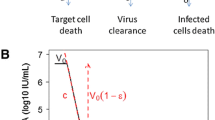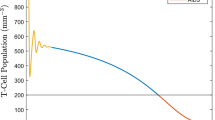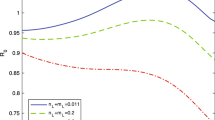Abstract
The discrepancy in the turnover of cells and virus in different organs or viral reservoirs necessitates the investigation of multiple compartments within a host. Establishing a multi-compartmental structure that describes the complexity of various organs, where viral infection comprehensively proceeds, provides a modeling framework for exploring the effect of spatial heterogeneity on viral dynamics. To successfully suppress within-host viral replication, it is imperative to determine drug administration during therapy, particularly for a combination of antiretroviral drugs. The proposed model provides quantitative insights into pharmacokinetics and the resulting virus population, which substantially relates to environmental heterogeneity. The main results are the following: (1) A model incorporating drug treatment admits threshold dynamics, driving to either viral extinction or uniform persistence, regardless of non-trivial initial infection, in the entire system. (2) Viral infection may be underestimated if a well-mixed (single-compartmental) model is used. (3) Optimal drug administration depends not only on the drug distribution over various compartments but also on the timing, described by phase shifts, of the administration of different drugs in a combined therapy.








Similar content being viewed by others
References
Bocharov G, Klenerman P, Ehl S (2003) Modelling the dynamics of LCMV infection in mice: II. Compartmental structure and immunopathology. J Theor Biol 221:349–378
Browne CJ, Pilyugin SS (2012) Periodic multidrug therapy in a within-host virus model. Bull Math Biol 74:562–589
Browne CJ, Pilyugin SS (2016) Minimizing \({\cal{R}_0}\) for in-host virus model with periodic combination antiviral therapy. Discrete Contin Dyn Syst Ser B 21:3315–3330
Chen SS, Cheng CY, Takeuchi Y (2016) Stability analysis in delayed within-host viral dynamics with both viral and cellular infections. J Math Anal Appl 442:642–672
Cheng CY, Dong Y, Takeuchi Y (2018) An age-structured virus model with two routs of infection in heterogeneous environments. Nonlinear Anal RWA 39:464–491
Cheynier R, Henrichwark S, Hadida F, Pelletier E, Oksenhendler E, Autran B, Wain-Hobson S (1994) HIV and T cell expansion in splenic white pulps is accompanied by infiltrationof HIV-specific cytotoxic T lymphocytes. Cell 78:373–387
Costiniuk CT, Jenabian MA (2014) Cell-to-cell transfer of HIV infection: implications for HIV viral persistence. J Gen Virol 95:2346–2355
Culshaw RV, Ruan S, Webb G (2003) A mathematical model of cell-to-cell spread of HIV-1 that includes a time delay. J Math Biol 46:425–444
De Boer RJ, Ribeiro RM, Perelson AS (2010) Current estimates for HIV-1 production imply rapid viral clearance in lymphoid tissues. PLoS Comput Biol 6:e1000906
De Leenheer P (2009) Within-host virus models with periodic antiviral therapy. Bull Math Biol 71:189–210
d’Onofrio A (2005) Periodically varying antiviral therapies: conditions for global stability of the virus free state. Appl Math Comput 168:945–953
Dixit NM, Perelson AS (2004) Complex patterns of viral load decay under antiretroviral therapy: influence of pharmacokinetics and intracellular delay. J Theor Biol 226:95–109
Dye C, Scheele S, Dolin P, Pathania V, Raviglione MC (1999) Global burden of tuberculosis-estimated incidence, prevalence, and mortality by country. JAMA 282:677–86
Fried MW, Shiffman ML, Reddy KR, Smith C, Marinos G, Goncales FL Jr, Haussinger D, Diago M, Carosi G, Dhumeaux D, Craxi A, Lin A, Hoffman J, Yu J (2002) Peginterferon alfa-2a plus ribavirin for chronic hepatitis C virus infection. N Engl J Med 347:975–982
Fung HB, Stone EA, Piacenti FJ (2002) Tenofovir disoproxil fumarate: a nucleotide reverse transcriptase inhibitor for the treatment of HIV infection. Clin Ther 24:1515–48
Gower E, Estes C, Blach S, Razavi-Shearer K, Razavi H (2014) Global epidemiology and genotype distribution of the hepatitis C virus infection. J Hepatol 61:S45–S57
Graw F, Perelson A (2013) Spatial aspects of HIV infection. In: Ledzewicz U, Schättler H, Friedman A, Kashdan E (eds) Mathematical methods and models in biomedicine. Springer, New York, pp 3–31
Heath SL, Tew JG, Tew JG, Szakal AK, Burton GF (1995) Follicular dendritic cells and human immunodeficiency virus infectivity. Nature 377:740–744
Hlavacek WS, Wofsy C, Perelson AS (1999) Dissociation of HIV-1 from follicular dendritic cells during HAART: mathematical analysis. Proc Natl Acad Sci USA 96:14681–14686
Hollinger F, Liang T (2001) Hepatitis B virus. In: Knipe DM et al (eds) Fields virology, 4th edn. Lippincott Williams & Wilkins, Philadelphia, pp 2971–3036
Holmes KK, Sparling PF, Stamm WE, Piot P, Wasserheit JN, Corey L, Cohen MS, Watts DH (eds) (2008) Sexually transmitted diseases, 4th edn. McGraw Hill, Toronto
Hübner W, McNerney GP, Chen P, Dale BM, Gordan RE, Chuang FYS, Li XD, Asmuth DM, Huser T, Chen BK (2009) Quantitative 3D video microscopy of HIV transfer across T cell virological synapses. Science 323:1743–1747
Kepler TB, Perelson AS (1998) Drug concentration heterogeneity facilitates the evolution of drug resistance. Proc Natl Acad Sci USA 95:11514–11519
Lai X, Zou X (2014) Modelling HIV-1 virus dynamics with both virus-to-cell infection and cell-to-cell transmission. SIAM J Appl Math 74:898–917
Lai X, Zou X (2015) Modeling cell-to-cell spread of HIV-1 with logistic target cell growth. J Math Anal Appl 426:563–584
Markowitz M, Louie M, Hurley A, Sun E, Di Mascio M (2003) A novel antiviral intervention results in more accurate assessment of human immunodeficiency virus type 1 replication dynamics and T-cell decay in vivo. J Virol 77:5037–5038
McFarren A, Lopez L, Williams DW, Veenstra M, Bryan RA, Goldsmith A, Morgenstern A, Bruchertseifer F, Zolla-Pazner S, Gorny MK, Eugenin EA, Berman JW, Dadachova E (2016) A fully human antibody to gp41 selectively eliminates HIV-infected cells that transmigrated across a model human blood brain barrier. AIDS 30:563–572
Mohri H, Bonhoeffer S, Monard S, Perelson AS, Ho DD (1998) Rapid turnover of T lymphocytes in SIV-infected rhesus macaques. Science 279:1223–1227
Nowak MA, May RM (eds) (2000) Virus dynamics. Oxford University Press, New York
Perelson AS, Nelson PW (1999) Mathematical analysis of HIV-1 dynamics in vivo. SIAM Rev 41:3–44
Posny D, Wang J (2014) Computing the basic reproductive numbers for epidemiological models in nonhomogeneous environments. Appl Math Comput 242:473–490
Qesmi R, Elsaadany S, Heffernan JM, Wu J (2011) A hepatitis B and C virus model with age since infection that exhibits backward bifurcation. SIAM J Appl Math 71:1509–1530
Ramratnam B, Bonhoeffer S, Binley J, Hurley A, Zhang L, Mittler JE, Markowitz M, Moore JP, Perelson AS, Ho DD (1999) Rapid production and clearance of HIV-1 and hepatitis C virus assessed by large volume plasma apheresis. Lancet 354:1782–1785
Richman DD (ed) (2004) Human immunodeficiency virus. International Medical Press, London
Rong L, Feng Z, Perelson AS (2007a) Emergence of HIV-1 drug resistance during antiretroviral treatment. Bull Math Biol 69:2027–2060
Rong L, Feng Z, Perelson AS (2007b) Mathematical analysis of age-structured HIV-1 dynamics with combination antiviral therapy. SIAM J Appl Math 67:731–756
Rong L, Perelson AS (2009) Modeling HIV persistence, the latent reservoir, and viral blips. J Theor Biol 260:308–331
Shen L, Alireza Rabi S, Sedaghat AR, Shan L, Lai J, Xing S, Siliciano RF (2011) A critical subset model provides a conceptual basis for the high antiviral activity of major HIV drugs. Sci Transl Med 3:91ra63
Shen L, Peterson S, Sedaghat AR, McMahon MA, Callender M, Zhang H, Zhou Y, Pitt E, Anderson KS, Acosta EP, Siliciano RF (2008) Dose-response curve slope sets class-specific limits on inhibitory potential of anti-HIV drugs. Nat Med 14:762–766
Spouge JL, Shrager RI, Dimitrov DS (1996) HIV-1 infection kinetics in tissue cultures. Math Biosci 138:1–22
Smith HL (1995) Monotone dynamical systems: an introduction to the theory of competitive and cooperative systems. In: Mathematical surveys and monographs, vol 41, AMS, Providence
Smith HL, Walman P (eds) (1995) The theory of the chemostat. Cambridge University Press, Cambridge
Strain MC, Richman DD, Wong JK, Levine H (2002) Spatiotemporal dynamics of HIV propagation. J Theor Biol 218:85–96
Thieme HR (1992) Convergence results and a Poincaré–Bendixson trichotomy for asymptotically autonomous differential equations. J Math Biol 30:755–763
van den Driessche P, Watmough J (2002) Reproduction numbers and sub-threshold endemic equilibria for compartmental models of disease transmission. Math Biosci 180:29–48
Vaidya NK, Rong L (2017) Modeling pharmacodynamics on HIV latent infection: choice of drugs is key to successful cure via early therapy. SIAM J Appl Math 77:1781–1804
Wang W, Zhao XQ (2008) Threshold dynamics for compartmental epidemic models in periodic environments. J Dyn Differ Eq 20:699–717
Wang Z, Zhao XQ (2013) A within-host virus model with periodic multidrug therapy. Bull Math Biol 75:543–563
Zhang L, Dailey PJ, Gettie A, Blanchard J, Ho DD (2002) The liver is a major organ for clearing simian immunodeficiency virus in rhesus monkeys. J Virol 76:5271–5273
Zhang F, Zhao XQ (2007) A periodic epidemic model in a patchy environment. J Math Anal Appl 325:496–516
Zhang C, Zhou S, Groppelli E, Pellegrino P, Williams I, Borrow P, Chain BM, Jolly C (2015) Hybrid spreading mechanisms and T cell activation shape the dynamics of HIV-1 infection. PLOS Comput Biol 11:e1004179
Zhao XQ (ed) (2003) Dynamical systems in population biology. Springer, New York
Author information
Authors and Affiliations
Corresponding author
Additional information
Publisher's Note
Springer Nature remains neutral with regard to jurisdictional claims in published maps and institutional affiliations.
S.-S. Chen and C.-Y. Cheng were partially supported by the Ministry of Science and Technology of Taiwan, ROC (Grant Nos. MOST 107-2115-M-003-008 and MOST 107-2115-M-153-005); L. Rong was partially supported by the National Science Foundation Grant DMS-1758290.
Rights and permissions
About this article
Cite this article
Chen, SS., Cheng, CY. & Rong, L. Within-Host Viral Dynamics in a Multi-compartmental Environment. Bull Math Biol 81, 4271–4308 (2019). https://doi.org/10.1007/s11538-019-00658-1
Received:
Accepted:
Published:
Issue Date:
DOI: https://doi.org/10.1007/s11538-019-00658-1
Keywords
- Within-host virus
- Heterogeneous environment
- Periodic drug treatment
- Viral invasion threshold
- Optimal drug administration




